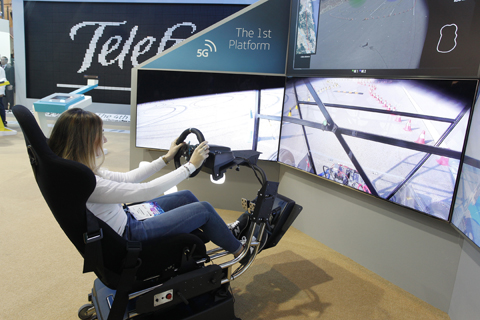- World’s first 5G remote driving concept showcases 5G’s reliability, high data transmission capacity and low latency – key elements for remotely driven cars.
- Driver in remote location gets “in car” experience thanks to 4K video streams and sensors transmitting from the car to the seat, and haptic control/feedback on the steering Wheel.
- Revolutionary real time demo developed by Telefonica, Ericsson, the Swedish Royal Institute of Technology (KTH) and Applus Idiada.
Madrid, 27 de febrero de 2017.- As part of their collaboration for 5G research, Telefónica and Ericsson (NASDAQ:ERIC), in partnership with KTH and Idiada, showcase the potential of 5G networks to transform industries, such as automotive. The demo uses Telefonica’s trial 5G network to drive a car prototyped by KTH at Idiada’s race track in Tarragona, Spain, from remote locations at Fira (Telefónica and Ericsson’s booths).
Telefónica is making fast progress toward building a network designed with the future in mind. The company believes that the start-up of 5G networks is not tied to a specific single event but rather a process that the company has already begun. The evolution of LTE can bring in advance a good part of these 5G features so we are focused on completing nationwide LTE coverage, simplifying the network and increasing capacity progressively as traffic demands it and devices support it.
Telefónica is also preparing for 5G by testing CloudRAN functionality in lab and field, developing and applying network virtualization (NFV/SDN) to an extensive number of network functions, working in the Fixed-Mobile convergence in all network layers and trialling new antenna systems.
With some 30 5G research agreements around the world, Ericsson and its partners are focusing their collaboration on finding and developing real use cases for industries. Ericsson expects that by 2026 there will be a USD 582 billion market opportunity globally as telecom operators leverage 5G technology for industry digitalization. For operators, this represents a potential to add 34 percent growth in revenues in 2026.
This demo shows one of the most advanced applications of the so-called “haptic communications” (also known as “tactile Internet”) which has the ability to control machines, including vehicles, by means of wireless connections. In order to cope with the technical challenges behind it, Telefónica and Ericsson have jointly demonstrated the ability of 5G to provide a completely different experience, based on immersive perception of reality rather than the more traditional connectivity concept.
The demo is technically supported by high-frequency spectrum (15GHz), with ultra-narrow beams which follow the car / prototype continuously from the 5G base station – both located at the circuit of Applus Idiada, 70 km from the Fira – in order to ensure the reliability and ultra-low latency required by the whole network that connects the cars with the Fira. This is needed not only to access 5G but also for the network transport function. Several 4K videos streamed through that network will give the driver located remotely a complete and detailed sensory perception.
Finally, this demo shows the potential of 5G to unlock new and exciting opportunities from markets such as the automotive sector which, properly addressed, can revolutionize traffic control in many ways.
Enrique Blanco, Telefónica’s global CTO, has stressed that “5G technology provides the next level of customer experience, as well as the ability to deliver services faster, more flexibly and customized for specific applications. Beyond new radio capabilities, we try to show the new paradigms in network architectures. It is the networks that adapt to the needs of our customers, based on virtualized structures. The 5G demo we bring to this year’s MWC along with our partners goes beyond excellent connectivity and anticipates new possibilities that will provide characteristics of 5G going forward”.
José Antonio López, Head of Ericsson in Iberia, says: “Partnerships will be key for the success of 5G. Ericsson has launched world’s first 5G platform and we have signed 5G collaboration agreements with 30 operators, 20 industry partners and 45 universities and institutes around the world. We are glad to partner with Telefónica to, once again, be ahead of the game and bring an end to end 5G Experience to MWC 2017”.
This demonstration, available at both Telefonica’s and Ericsson’s stands in MWC 2017, is the first application of its kind and has been developed with leading technology from participating partners: 5G network built by Ericsson and operated by Telefonica -providing transport on its network-, sensors and haptic system developed by KTH and the testing capabilities from Idiada.
-
Enrique Blanco, Telefónica’s global CTO -
Telefónica and Ericsson, in partnership with KTH and Idiada, showcase the potential of 5G networks to transform industries, such as automotive
